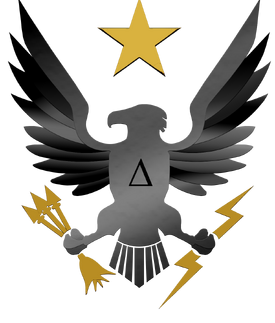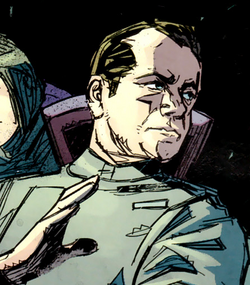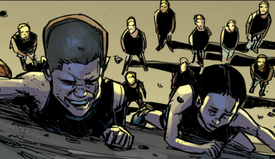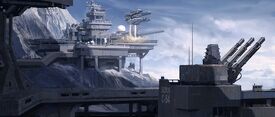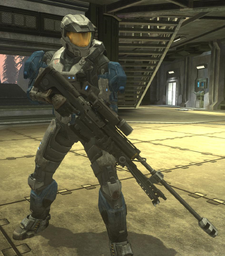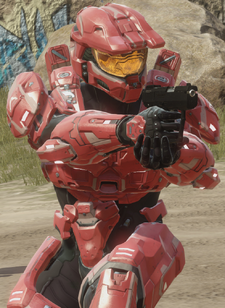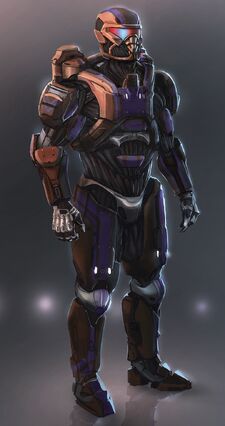
|
This article, Delta Company, was voted as the Legendary Article of 2016 in the Ninth Annual Halo Fanon Wikia Awards. |

|
This article, Delta Company, written by S-D379, KingOfYou115, Sev40, and Shivly, was voted as the Best Organization of 2016 in the Ninth Annual Halo Fanon Wikia Awards. |
| This fanfiction article, Delta Company, was written by S-D379, KingOfYou115, Sev40 and Shivly. Please do not edit this fiction without the writers' permission. |
| This article, Delta Company, is currently under active construction. |
| This is a fanon expansion of a canon element. To see the original canon article, follow the link to Halopedia: Delta Company. |
Delta Company, also known as SPARTAN-III Program, Class IV was a rogue class of super-soldiers developed in secret under the command of ONI Section Three's Beta-5 Division. Formed from the consenting candidates recovered between 2551 and 2552, the project was a radical change from its predecessors, with each Spartan intended to survive longer and used in smaller-scale stealth missions, rarely ever being deployed as a complete unit. For this reason, their comparatively shortened training program emphasized their ability to work as a team while also rewarding some independent decision-making skills. At the same time, attachments or bonds to non-Spartans who weren't their commanding officer or even their peers in other teams were strongly discouraged, with each team developing a strong sense of competitiveness against each other. This method of extensive stealth, Headhunter-like training structure allowed them to perform best against a range of comparable opponents, such as other Spartans. After undergoing their experimental augmentation procedures, the Deltas who survived were provided with the MJOLNIR Powered Assault Armor, used by the legendary SPARTAN-IIs, and were deployed on various black operations and hunter missions. Although the company was ultimately disbanded after being discovered, the Deltas continued to be a vital weapon against high-value targets such as rogue spartans for years afterward, and were proved to be important assets after their actions during the Created crisis. OutlineThe highly-secret SPARTAN-III program, started by Colonel James Ackerson and Lieutenant Commander Kurt Ambrose was created in order to create cheap and expendable soldiers who would embark on suicide missions with high strategic importance and an equally high risk. The first set of the soldiers, called as Alpha Company, were all wiped out during Operation: PROMETHEUS, and similarly the second set called Beta Company were killed in Operation: TORPEDO. Soon after the graduation of Gamma Company, the Human-Covenant war worsened, and its Spartans were called to assist the mainline human forces. After the Gamma Company Spartans were repurposed and taken away from Onyx, new plans were being made for the next set of soldiers, Delta Company. All the resources and materials, whatever needed for Delta Company were transported to Onyx to set up everything and commence the training by the frigate the UNSC Agincourt. Before the frigate left, Lt. Commander Ambrose asked the ship for assistance in observing the competition between the top three Gamma Company teams--Saber, Katana, and Gladius, on Onyx, in order to get the top honors. However, the entire situation changed when the Onyx Sentinels attacked, resulting in the Onyx Conflict and the death of Ambrose. Soon after that, during the Battle of Mare Erythraeum, Colonel Ackerson was taken prisoner by the Covenant and was subsequently killed. Without the two heads running the program, Delta Company was shut-down by the Office of Naval Intelligence, and all its funding was diverted to the ongoing war. All traces of it were removed from the computers and its files were purged, although the top-ranking ONI brass still knew about it. However, it was soon suggested by Beta-5's director Jazmine Utah, on such official for Delta Company to be revived. Originally meeting with criticisms, after the occurrence certain incident, Utah, along with Captain Andrew Johnson, secretly revived the project for personal uses. HistorySelection
Though the selection process for the future members of Delta Company was in a process of rushing in 2551 to 2552, the origins of the selection could be found four years before. With Gamma Company's training well underway, agents from Section-II began analyzing data from the recent 2545 CAA Human Citizen Census and the on-going vaccination programs to find possible candidates who may fulfill the age range that was sort after in earlier companies. Those who met the genetic profile sought were then organized by the likelihood their planet would be invaded by the Covenant, then the risk of how likely their home cities or towns would be chosen as targets for the Covenant. As time went on, measures were put in place to ensure what as many potential candidates survived, including creating child-only evacuation craft. To avoid losing track of the candidates in other orphanages across the remaining worlds, as what happened to previous companies in the past, they were injected with a newly-developed organic tracking solution into their bloodstream. This was all completed by 2549, when enough possible candidates had been surveyed that made the fourth company viable. When 2551 came around, however, enough problems arose that required another validation of the remaining candidates on the list. This was caused by two main problems. Firstly, while ONI was successful at guaranteeing the safety of most of the candidates, a small portion was located on worlds that had not been attacked, but bypassed entirely by the Covenant's invasion fleets. This made those candidates harder to interview and retrieve, much less want to leave in the first place, resulting in them being cut from the list. Secondly and most significantly was Ambrose's research into augmentation failures. He released a new set of required genetic markers based on incompatible gene sequences which led to their bodies rejecting the drugs, resulting in a complete re-evaluation of the candidates. When all this was finished, the number of children compatible dropped from just over three hundred to half that number. With the future of his brainchild now in risk, it didn't take long for Ackerson to find out.
With pressure from even higher-ranking ONI officers such as Admiral Parangosky, Ackerson authorized the creation of at least four hundred and seventy-five soldiers. To gain such vast amounts of soldiers, he made a number of changes to the selection criteria; many of which were based on those used by the older Gamma Company. Predictably, Ackerson's orders to downgrade the genetic code requirements to "recommended" infuriated Ambrose, who immediately and stubbornly demanded those to be reinstated as mandatory. However, as Ambrose had no alternate ideas for how to get so many candidates, it stood for the rest of the selection process. Luckily for Ambrose, these measures proved to be unnecessary when in 2552 a new wave of orphans resulted from the destruction of the Epsilon Eridani colonies; a horrible price to allow the continuation of the SPARTAN-III program. Even while Section-II was still cataloging the possible candidates present in the refugee camps, both Ackerson and Ambrose reluctantly allowed them to begin evaluating and if possible recovering them. Because of this, by the Battle of Onyx right at the end of the war, four hundred and ninety-seven candidates had been surveyed for possible proposal and at least three hundred and forty had already been recovered. However, at this time the candidate collection stopped; the deaths of both the administrators and many of the employees of the SPARTAN-III program left almost nobody to run it. Coupled with ONI's public support for the SPARTAN-IV Program, there was also little interest in establishing what could be argued as an obsolete program. Reestablishment and RecruitmentHowever, not all high-ranking ONI officials saw the redundancy of another class of SPARTAN-IIIs. Admiral Jazmine Utah, the ruthless director of Beta-5's special projects, was merely the only one to take action. She was concerned that massive breach of security that was GEN2 MJOLNIR and the SPARTAN-IVs, along with the illegal drugs that the Gamma Company Spartans took, would eventually culminate in a supersoldier crisis within the next few decades. She pointed out that the easiest solution was to use the recruited Delta candidates and modify their planned training regime and equipment to make them much more efficient at killing other Spartans. There was a large problem, one which threatened to shut down the company before it even begun; how to gain a large enough budget to pay for all of this, as HIGHCOM would never approve of this because it relied on child soldiers. In the end, it was decided that as well as setting up false businesses and fundraisers, she and a couple of her most trustworthy officers would approach a number of commanders in all branches of the UNSC which were most likely to support them. While a few such as Captain Andrew Johnson were easy to convince about the necessity of the program, most others approached had declined out of fear of repercussions from Section Zero, or were already promised a private spartan of their own by the Spartan Branch. Fortunately for her, the unpredictable nature of the SPARTAN-IVs quickly surfaced not long after the Human-Covenant War. Incidents of rebelling Spartans, culminating in the attempted theft of the UNSC Infinity, served to under the reliability of the SPARTAN-IV program. By capitalising on this potential while contrasting them with the service record of SPARTAN-IIIs, those officers approached again became increasingly unnerved at the real risk of insurgents infiltrating the program[2]. Many of these supporters assisted in Beta-5's attempts at setting up proxy organizations and projects to fund Delta Company. Some even contributed important assets - the acquisition of Kyle-B115, Ren-172 and Harald-077 from the Spartan branch were by far the most valuable, and the three quickly became the core of the project, using their own experiences to train a better batch of supersoldiers. Only after the budget was calculated and the project's administrative personnel were appointed did Utah allow the collection of the trainees. In the first test of Johnson's organizational skills, he quietly organized teams of loyal agents to steal away the candidates, relying on the data that was provided from the employees chosen to monitor the recruit's position and status. As the teams did not have the benefit of a large carrier or a sizable fleet of small slipspace-capable ships such as Condors and Prowlers, they had to rely on hired freighters to ferry the recruits close to Argus V, the planet chosen for their training site. The recruits were cryogenically frozen before being loaded into falsely-named containers guarded in shifts from the acquisition teams. The last leg of the journey to the base itself was taken by the few ships Beta-5 had on hand. While the heightened security of ONI's bases often meant that a number of candidates had to be abandoned, an impressive 300 candidates were still collected throughout the retrieval process. TrainingConditioning & Early DevelopmentThe recruits arrived at Argus V throughout the rest of the year in the UNSC freighter Give Me More, being immediately moved to their training base, now designated Camp Ambrose almost as soon as they had been recovered. The recruits frequently moved quarters thanks to the fact that the base was still under construction. By the time the final candidates arrived on the 4th December 2553, it was only just nearing completion; despite this, the trainers and administrative personnel couldn't find a reason not to postpone the training any longer. The recruits were called into the compound's mess hall, where the staff introduced them to the program. The appearance of the enlisted AIs and a short film, as well as the appearance of Kyle and Ren in full armor, were there to further interest and excite the recruits. After the meeting was over, the trainees were then shoved into the same freighter that brought them to Argus V, which took them several kilometers into the sky. Before they were asked to jump, they were given and taught how to operate the Falcon Wing Parafoils. Impressively, almost everyone made the jump, with an exception of some twenty recruits who either refused to jump or were badly injured when they crashed into the ground. Without a way to smuggle them back into society without arousing suspicion, the children were taken to another base on the planet where they were trained to become researchers, ONI agents or, more simply, normal people. The other three hundred, meanwhile, were congratulated by their head trainers in qualifying for the program, before being sent to bed.
Over the next year, the recruits were forced to endure a grueling exercise and discipline program, not unlike those of its predecessors. A typical day involved the candidates being waked up either an hour before or after Argus' binary stars rose over the horizon - the time varies in response to the trainees' need for sleep. Their day was divided into seven periods, with two being dedicated lunch sessions and the other five shared between academic study and physical exercise. Depending on whichever group they were divided into, which were based on how much education they received prior to being recruited, the trainees could expect a maximum of eight hours worth of physical exercise dominated by runs and repeated squats. It can also involve games testing the trainees' coordination and critical thinking, such as the classic Ring the Bell dating back to the days of the SPARTAN-IIs,[3]. Their academic study was similar to their predecessors, with the tutors first teaching English and general Mathematics before moving onto military theory. Classes performing poorly were given additional support from on-site assistants and a training program built into their AI tutor, Oracle; this included a dedicated English course for those who did not learn English as their first language. The only major difference was that the schooling emphasized the indoctrination even more in an attempt to ensure that the vast majority of Delta trainees would recognize that their superiors were always right. During these sessions, a punishment-and-reward system was enforced in a curious way; while discipline-related incidents such as backchatting were treated harshly, fights and arguments between other Delta trainees were not. Because of this, it took almost a year and a half to completely eradicate the most serious of issues in the trainees. Early training and conditioning also involved the inclusion of speeding up the mental and physical growth processes of the recruited trainees. Growth hormones and supplements were added to the children's meals and steroidal injections and injections for modified genes were commonplace - fear of needles was quickly eradicated among the child population. These modifications to the future Spartans' minds and bodies would make them more tolerant of their military training regime and to improve the brain activity of the children in a way that would make them more alert and attentive to a fractional degree. While it wasn't game changing - it was deemed a worthwhile endeavor in an attempt to speed up the graduation rate of the children over the course of the first four years of training that was planned out by Utah and her people. Training would continue after the first four years, however, upon completion of the initial time frame - the Spartans would be pushed into active combat roles as many in Utah's inner circle knew, there was a great risk that the illegal Spartan program would be discovered. Combat TrainingAs soon as most major discipline issues were cleared up and the trainees finally adapted to the exercise routine, the training groups were again split and mixed up into smaller groups in preparation for their official induction to combat training. This caused a slight reorganization in their timetable, with practical training sessions taking up three sessions originally dedicated to exercise. During these sessions, under the watchful eye of an increased number of drill sergeants, were taught the necessary skills needed in the field. This included learning to maintain their equipment, apply battlefield first aid and the basics in circuitry, all adapted to be safer to remove the risk of harm. More dangerous acts, such as firing a firearm or taking apart a given piece of technology, were only done when all three of the head trainers and the sergeant responsible for a particular group trusted their trainees completely. Extensive changes also occurred in their exercise sessions. While the need to keep their physique in shape was reduced now that they had a base to improve upon, the training was no less easy on them for a different set of reasons. Part of the difficulty was from their rigorous close-combat training, created by Ren-172 but continuously optimized for their current state by Kyle-B115. Taught by Ren and Harald, the veteran Spartans would teach the trainees various styles of martial arts with a more lethal edge, along with knife-fighting and sword-fighting techniques. Even here, the core of the training revolved around helping the Spartans to hold foes of similar or superior abilities, whenever on equal terms or being outnumbered. To ensure the Deltas mastered what they were taught, the trainees either fought against each other in a one-on-one arena or were sent into the ring with a drill sergeant in a timed brawl where the trainee needs only to survive. Later tests would involve the drill sergeants carrying a varying amount of weights on their arms to simulate three main types of enemies they would encounter: "tanks", which are slower than the average Delta but can still take a beating, "berserkers" which are faster and stronger, and normal sergeants which are intended to symbolise soldiers which are all-around better. These later tests typically came with a dedicated course filled with foot soldiers. Unlike every other course, the Deltas started during this time, the close-combat training would continue well after the Deltas were assigned into teams, although modified to accompany the presence of an entire Delta team rather than a single or pair of trainees. A different, uncommon type of competition included a specific object, mostly a flag, being hidden somewhere in the dense forests near the camp by the DIs. Motion trackers would be installed almost everywhere, coupled with machine turrets shooting TTR rounds. The various recruits sent in would have to locate the flag, fight or evade other recruits they encounter, and bring the flag back to the Camp's shooting range and ring the bell, all while staying low and not being detected by the trackers. If hit by enough TTR rounds to immobilize them, they would be marked 'neutralized' and wouldn't be allowed to continue participation in the competition. In some cases, the recruits would have to disable the trackers or co-operate with others to gain victory, although this rarely happens. While Delta Company was an ambitious project, it's leaders were aware that their days were numbered so accelerated training methods were introduced into the combat portion of Delta's early training period in an effort to get children used to battlefield conditions and combat sensory overload. Accelerated training involved the addition of simulation suits and an augmented reality simulator similar to the one based on the ANVIL Station and the UNSC Infinity. Children were pressed through horrors of battle and provided ample time to adjust themselves to the simulated battlefield conditions, to the point that it became something of a normality. Combat became just another ingrained concept in the minds of the child soldiers. The combat simulator was also employed to get the Spartans ready for life fire training sessions later on and teaching how to handle themselves and their weapons in battle. It was a rudimentarily basic step toward getting the Spartans ready to become masters of warfare. Teambuilding and Further Development
In late-2555, the trainees had their training suspended for a major meeting in the Camp's mess hall. Using data gathered all throughout their training, Kyle announced the permanent team assignments, as well as their associated drill instructors - a long-awaited and heavily-hyped event among the trainees. These teams were pulled together based on their effectiveness and coordination in previous exercises, with each individual's skills, weaknesses and to a lesser extent opinions of each other being considered. However, in a select few cases, a number of teams were created through combinations not considered ideal to test how they respond. Once this was done, Kyle made a surprise announcement about each cabin housing two teams. Each team was initially uneasy about this, and the outcome was different for the "sister teams" - some would become very close allies, while others would be capable rivals. Although most of their training up until this point was focused towards individual skill development, this did not mean that the drill instructors abandoned all attempts at fostering teamwork and co-operation. There were many team-based competitions organized, designed by the trainers. Standard competitions included Spartan teams, which were reorganized regularly based on their performance, fighting against each other in the forests for a fixed amount of time, and the number of 'kills' they got would give them points. In Delta Company, the teams' ranking was mostly based on the points they accumulate during their training and competitions, with the drill instructors being the judges. The lower performing teams would be continuously shuffled and reorganized, to see in which way they would suit the best, while the top-ranking teams seldom saw such activities happening to them. The 'Capture the Flag' mechanic was later adopted in a teams format, on requests by Kyle-B115, with the teams having to compete and bring the flag. If two or more teams worked together, the points would be divided between them based on how active they were. Additionally, there were real challenges to analyze how much they had learned or improved from the competitions. Called the "Infiltration Events", these were specifically designed by the three Spartan-trainers and Oracle, chiefly Ren-172, that happened twice every month. In this, a custom-made outpost was built, complete with motion trackers, heat signature trackers, turret-mounted Gatling guns and various guards and their DIs guarding it. The selected team's objective would be to neutralize the base, in their own way. They could bust their way in and drop all the guards and DIs, stealthily take down the security, or just reach its inner room, called the 'TagPlace' and set a special beacon they receive before the event starts, to notify that they had secretly come past the guards. Points were given based on their performance, with the beacon method earning the least points and the stealth method earning the most. If they were found out, or their cover was blown, points would be deducted. Thus, everything depended on them being stealthy enough and neutralizing the enemies without even getting spotted. Bigger versions of the Infiltration Events would include a large outpost, or more importantly, a small base, and various teams working together to win. Role & Usage
The original aspirations for Delta Company prior to the deaths of the project's command staff, being mass-deployed in suicide missions, were reevaluated at being no longer necessary in the aftermath of the Human-Covenant War, as well an unacceptable loss of potential. The reformed project instead sought to mold the trainees into their secret weapon. All Delta teams were trained for to complete various black operations without being caught or identified, and typical missions they were assigned ranged from establishing a data flow back to the nearest Beta-5 facility to raiding heavily-guarded compounds for the purpose of assassination or theft. Given their advanced training, Delta teams are always deployed when strategic targets are protected by countermeasures which destroy the objective, such as database purges. When not in the field, Delta teams act as security specifically for the Division, protecting key personnel either by standing directly near her or clearing possible threats quietly. Finally, many Delta teams would be assigned into "Spartan Hunter" objectives, having learnt during their training the quirks and tendencies of the various Spartan types - especially those of rogue Deltas.[4] AugmentationsThe augmentations of Delta Company could be considered as a marvelous feat in biochemical engineering, as it managed to outweigh those of the other SPARTAN-III classes, or even the SPARTAN-IVs. Delta's augmented personnel could be roughly estimated to be as strong as the SPARTAN-IIs, even though the kids didn't have any requirement of specific genetic markers that the SPARTAN-IIs required. Thus, the Deltas were able to operate the MJOLNIR GEN2 armor much more effectively. However, since the number of rogue Delta operators started increasing exponentially, their threat to the UNSC grew as well, since they were stronger than typical SPARTAN-IVs, even while unarmored. This only added to the big list of why Delta should be completely shut-down after ONI's discovery of the illicit company. The Delta Augmentations, as they were colloquially called, was compiled from the best results of all the previous super-soldier programs Beta-5 had information on, mixed those with new procedures developed by the best of the UNSC Medical Corps. Like the SPARTAN-IIs, the augmentation procedures of Delta Company were both surgical and biochemical, maximizing the effectiveness. The revamped augmentations include the Tetra-Desophtate injection from Project ORION, the Occipital Capillary Reversal from the SPARTAN-II Program, etc.
Fortunately, there were no casualties in Delta Company during the chemical augmentation process; the experimental augs prepared by the scientists of Delta Company were indeed successful. All the 300 recruits survived the procedure unharmed. ControversiesBecause the SPARTAN-III was canceled following the destruction of Onyx, Delta Company never received approval from any leading figure or power in either ONI or the entire UNSC, and thus wasn't supposed to go underway. As a result, fear from troubles with funding or their peer sub-divisions bypassing too far into their own files, Beta-5 had inevitably developed several controversial practices which caused even its own employees to question whenever it was all necessary. FundingMuch like any other initiative, Delta Company was completely reliant on a budget to ensure it could even get past the planning stage. However, because of its huge cost was significantly higher than what Beta-5 could ever receive under normal circumstances, a mixture of falsified civilian organizations and more illegal and treasonous activities were undertaken. Although some in the division's administration attempted to draw money from the various programs under their authority, they eventually decided not to. This was because they were certain ONI budget expenditure analysts would quickly discover the large sums of money that went "missing", leading to a full-on investigation from either dedicated Section-Zero units or from the UEG's own corruption commission. The largest source of income came from civilian organizations, most of which were charities and supposedly not-for-profit companies. They ranged from varying backgrounds, and while were spontaneously created, a small number were bought outright after going bankrupt. As many such groups had suddenly popped up following the UEG's announcement to give out grants to those who would assist with the rebuilding, or in the case of charities existed throughout the entire Human-Covenant War, Beta-5's fakes were able to blend in well with the surface. As frustrating as it was that a number were rejected for these grants, they still generated significant revenue; it was speculated that, if all proved to be profitable ventures, they could provide up to tens of millions of credits within the entirety of Delta's training period. However, as time went on these groups attracted increasing suspicion from both experienced ONI agents and the public at large, mainly because they only spent a small amount on whatever they were supposed to do. The agents could even begin to associate which organizations were created by one ONI's sub-divisions since their sophisticated encryption technology used for their banking was second only to that of HIGHCOMM's private databanks - something only Beta-5 could achieve. It was through this that some individuals were able to discover the existence of Delta Company. Where the real criticism came from was where the remainder of the budget came from. A frighteningly common habit they developed early on, several Beta-5 teams were tasked to covertly hit the storage levels of known ONI bases. While they were encouraged to hit those with a direct economic value such as banking files, they allowed their teams to take whatever could be sold for a high price. Physical objects were planted with trackers before being sold to other parties, which allowed for a later strike to retrieve them back. The cycle could be repeated many times, though slowly became less effective over time as rumors began to emerge from survivors, claiming ONI's latest traps for rebel sympathizers involved giving them their technology before being attacked by a strike force. Additional funds were also retrieved from anti-Insurrectionist teams who discovered large credit stockpiles, although these were few and far between. Following the shut down of the Delta Initiative, many of the corporations used as fronts were brought into the light. While the overall repercussions were grave and greatly diversified, the intervention by ONI elements did reach the ears of some in the public sector, generating some bad publicity following the fall out of Delta Company's closure.
SecrecyTrainersWhile the original Delta Company under LCDR Ambrose had the luxury of highly-experienced Drill Instructors provided by Section Three for training, this was not the case with Beta-5's Delta Company. While Utah was struggling to bring back Delta Company, the problem of trainers was overruled by other major ones such as funding and location. After her initial reestablishment idea was rejected, she began sorting out each of the problems one by one and found solutions to nearly all of them. Supported by Johnson and Bruening, Utah made widespread announcement about the 'DELTA Initiative', an apparent training and learning course which recruited selected experienced soldiers not only from the UNSC, but also other private military organizations such as the Vanguard Corporation to become more comfortable with killing insurrectionists. The course would last for five years, with all kinds of intensive anti-insurgent fighting methods and demonstrations. Also, as a side concept, they'd learn to take on the various alien species encountered by humanity during the 27-year long Human-Covenant War, in the event of another inter-species war begins. However, only the higher-ranking staff of Delta Company knew that the DELTA Initiative was nothing but a falsified program in order to obtain instructors and trainers for Delta Company's training. Upon arrival, the DIs were informed they had one last opportunity to turn it down, as for after hearing about the program - they were forbidden from backing out or rejecting the offer. Originally planned as another falsified operation, Operation: INCOGNITO was ultimately shelved. The operation was supposedly a reconnaissance mission, with the Spartans Kyle-B115 and Ren-172 taking part in it. They were intended to lie deep behind Covenant Remnant lines, and carefully observe their tactics and their plans in order to be prepared for an all-out war with them. In reality, however, they were recruited as trainers for Delta Company. Bruening also managed to provide cover and include Harald-077 as the third trainer, finishing the trio. Following certain administrative changes and circumstances, the mission was shut down and the Spartans were legitimately acquired by legal means. Rogue OperatorsFollowing multiple accounts of rogue vectors and desertion by government-sanction supersoldiers and other alike personnel during and after the Human-Covenant War, the UNSC Security Council, responsible for executing military interests in human space and beyond, created a number of directives that would go on to formulate special laws and statutes that would handle the prosecution and dealings with the sensitive case of Spartans and other supersoldier-types. This culminated with the establishment of UNSC Security Council Directive 9901-002-S in the handling of rogue super soldiers. Depending on a case-by-case scenario, treason and desertion are treated with more flexibility and typical cases of military personnel designated absent without leave. Those who typical show now ill-will to the UNSC and Unified Earth Government are curtailed back into the military complex through contact and rehabilitation, going as far to appease certain concerns that Spartans may express with their station. Typically, this partial limiter is offered to Spartans of previous generations, S-IIs and S-IIIs. Delta Company is no exception, in fact, it might be a prime example of the Directive playing to a more adaptable and flexible role in dealing with what amounts to rogue minors, rather than military personnel. While previous hierarchies in the military chain-of-command might have considered Spartans synonymous with equipment, the sympathy displayed by former Spartans like that of ONI Director, Admiral Serin Osman, the Spartan Branch Secretary Rear Admiral Musa Ghanem, and Spartan Operations Chief of Staff Jun-A266, rogue Spartans are given more leeway in terms of treatment. In basic terms, if a rogue Spartan shows no ill-will toward the UNSC and its personnel, said Spartan may be accommodated and rehabilitated back into the military structure or at their own desire, retired by means of regressing their supersoldier implants and modifications. Those who do display ill-will are treated with less leniency and are likely marked with the goal of "kill or capture." Special task forces are typically employed to round up and successfully contained these developing threats like that of Operation: MAD DOG and others. Below are a few well-known rogue Delta Company operators:
EquipmentArmorMJOLNIR PAA/Mark V
Outdated, inefficient and largely unwanted, the second official platform of the MJOLNIR line was nevertheless a technological marvel which led to it being designated as the default armor for the company. It was, for its time, a revolutionary piece of hardware, including a significant number of innovations which changed the way Spartans can fight. The most important of these was its energy shielding system, allowing them to fight in hotly-contested zones without risking direct damage to their suits for a brief period. It also came with the ability to load reusable mission-specific modules to increase certain performance aspects, the most commonly-used for the Deltas is an easily-disturbed active camouflage field emitter. Other smaller additions include improved motion trackers and the larger fusion reactor to power the new equipment. The Mark V was widely produced between 2550 up until mid-2552 to improve the capabilities of every surviving SPARTAN-II and Cat-2 SPARTAN-III super-soldiers. However, the rapid redeployment or casualties these soldiers undertook and the sudden upgrade to the Mark VI and subsequently GEN2 armor so soon after the war has left several suits unlikely to be used again. That and the relative cheapness of its parts and construction meant that the Mark V quickly impressed the budget oversight officers enough to allow its mass-production for Delta Company. Concerns over its viability in stealth operations meant it was modified with a new design, such as RADAR-resistant materials, improved emission-capture systems and new VISR surveillance-detection software. The Mark V is used by most of the Delta Company Spartans, except the ones who are at the peak in training; instead, they were given more advanced iterations of the MJOLNIR armor. MJOLNIR PAA/Mark VI
The legendary MJOLNIR Mark VI was, despite its age, was still a very capable and well-rounded weapon in the UNSC's arsenal; however, its design places an emphasis on combat viability. This iteration included or improved all features added in its predecessors, such as stronger energy shielding, the ability to carry an AI and of course able to boost the strength, speed and reaction time of the user. The Mark VI made a number of new introductions as well; as well as improved software which made it easier to utilize dual-welding in certain weapons, the suit also contained an automated Biofoam injection system, allowing the user to fight for longer before medical attention is required. However, one thing it did not include was the ability to install reusable modules, though individual, single-use packs could still be used. Used by the higher-scoring recruits in competitions, the Mark VI's stealth variant was originally considered as the standard-issue power armor for the company, as it easily exceeded the stealth requirements desired by the administration. However, concerns about the armor's availability and excessive production costs led to it being replaced by its more economical predecessor. Meanwhile, the odd two dozen suits already acquired were given over to the teams who were assigned to more destructive missions than their other peers were intended for. These were quickly retired in 2558 when they were replaced by a stripped-down version of their unofficial successor, the MJOLNIR Mark VII. MJOLNIR PAA/Mark VII
While the Mark VI was given to the recruits who performed the best in the competitions, it's only use was to function as a temporary tool before their proper replacements arrived; the Mark VII. Over-budgeted and later deemed unnecessary due to the introduction of the second-generation of MJOLNIR, the Mark VII prototypes were scrapped by the high-ranking officials at ONI, specifically at the request of Vice Admiral Ned Rich. However, a secret cut-down variant was developed, unknown to many high-ranking people at ONI and UNSC. This variant featured many new stealth features and other upgrades, as well as removing some other ones that were deemed not-of-use for Delta Company Spartans. All the funding for this secret armor was done by Jazmine Utah herself. First entering service in May 2558, the Mark VII proved to be a deadly combination when paired with the best of the company. It's exceptionally heavy shielding and heat-resistant outer plating allows it to survive reentry, while its adaptive shield-shapers allows the user to change them into parafoils to ensure they made it safely onto the ground. The user can expand or reshape the shield bubble to what they desire, and under extremely-specific conditions can even recreate the GHOST-class' thermal dampening shield structure. Besides this, there are no other countermeasures for its thermal signature. It also comes with a dock for an active camouflage emitter. More powerful electromagnets were also installed in the gloves and boots, which can allow the user to not only scale buildings and remain on the surface of a ship, but also to attract stray weapons towards themselves if disarmed. While thrusters could be attached to hardpoints on the backside and thighs, two grappling hooks were installed into the gauntlets with the ability to extend about seven meters. GHOST-class Mjolnir Prototype
While the mainline Mark V was designated the mainline suit for the Deltas, its focus on combat meant that even with the stealth upgrades, there were concerns it would fall short in missions which demanded stealth over all else. For this reason, Utah persuaded the engineers at Damascus Materials to loan them their new GHOST-class prototype power armor for testing. More of a technology demonstrator than a variant, the GHOST was built around both Covenant active camouflage technology and ancient human stealth systems, giving it unparalleled stealth qualities. To further increase its effectiveness at infiltrating, the suit has a stripped-down design which sacrifices protection for improved flexibility and a lighter frame, and an experimental shield shaping system gives it's energy shields a curious insulating characteristic to cut down thermal radiation by as much as 35%. An emission-capture system was installed to trap additional heat. Finally, the helmet was outfitted with a VISR 6.0 which could highlight security systems detected by the operator or the armor's sensors, improving the situational awareness of the user and thus their ability to succeed in the mission. As required by GEN2 regulations, the helmet was compatible with other variations of the VISR line. While all these technological leaps gave the GHOST significant advantages over older systems, the suit was not without issues. Firstly, the suit was notoriously inefficient, meaning that deuterium-booster packs were essential if the user was required to use GHOST over an extended period of time. More minor but still dangerous risks relate to the fact most of the suits were still in the prototyping stage; as such, the chance of a certain system at best unresponsive or at worst exploding was higher than in other systems. Organisation and Personnel
While almost all of the trainers were experienced veterans of the Human-Covenant War, two of them were rather unlikely Spartans. With several fictional operations created as part of the DELTA Initiative, a number of Spartans served as trainers at least sometime during the Delta's training; Kyle-B115 and Ren-172 however both served as trainers during the entire training process.
QuotesAuthors' Notes
|
|||||||||||||||||||||||||||||||||||||||||||||||||||||||

